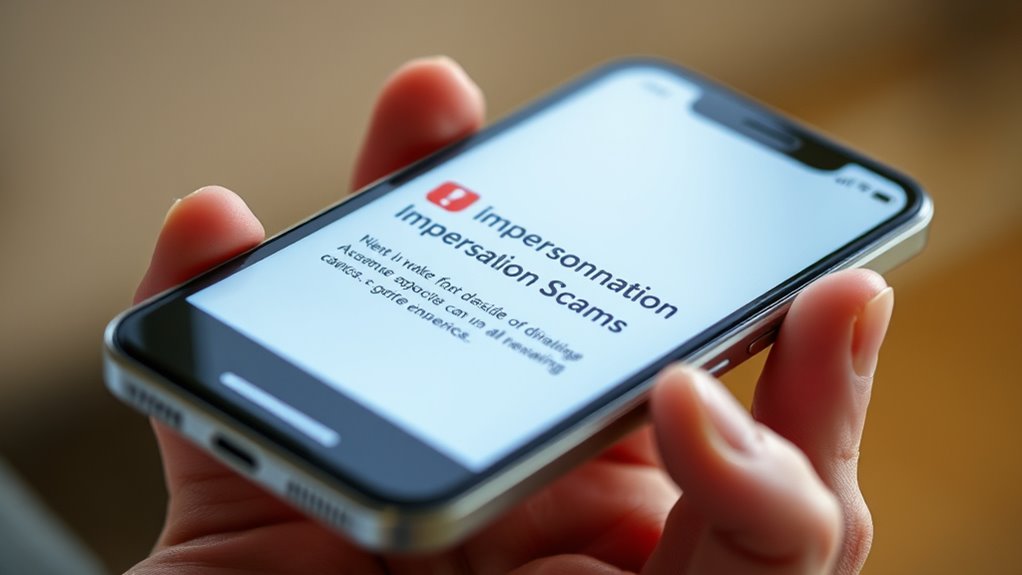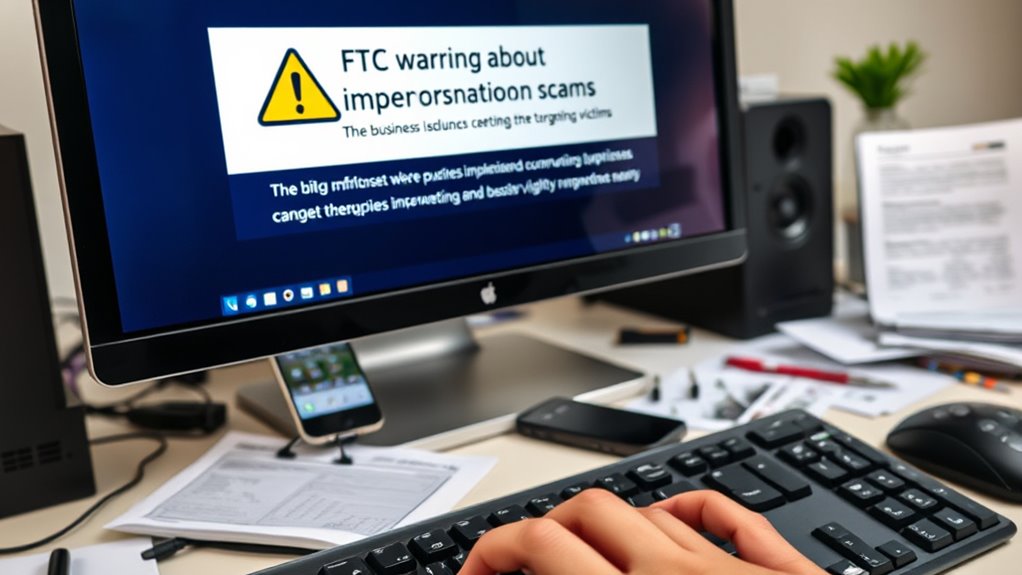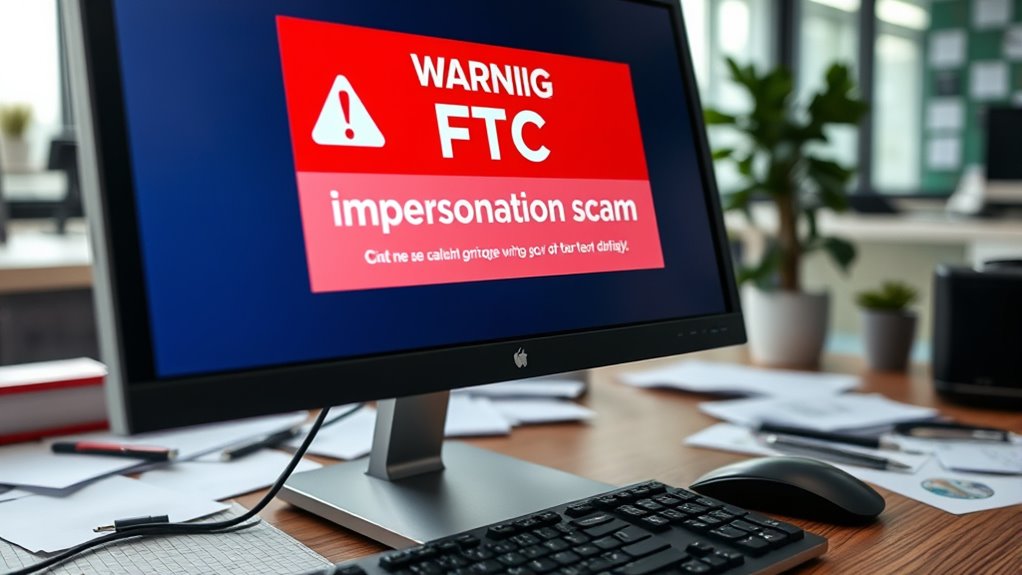The FTC warns that impersonation scams may come through calls, emails, or texts that pretend to be trusted agencies or companies, often threatening legal action or urgent payments. Scammers use fake IDs, official-looking messages, and urgent language to pressure you into sharing personal info or money. Protect yourself by verifying any suspicious contact directly with the organization. Staying alert helps you spot scams early—keep going to learn simple steps to stay safe and protected.
Key Takeaways
- The FTC warns about impersonation scams where fraudsters pose as trusted organizations to steal personal info or money.
- Scammers use fake calls, emails, and messages with official logos to deceive victims into urgent actions.
- The FTC advises verifying communications through official websites or contact numbers before responding.
- Vulnerable populations, especially older adults, are common targets for impersonation scams.
- Reporting suspected scams to the FTC helps authorities track and combat impersonation fraud effectively.
The Nature of Impersonation Scams and Their Impact

Impersonation scams are a widespread form of fraud where scammers pretend to be legitimate organizations or individuals to deceive you into giving away money or personal information. These scams are highly prevalent and cause significant financial harm, with people reporting losses of nearly $3 billion in 2024 alone. Scammers often pose as government agencies, banks, or familiar contacts to build trust quickly. They use sophisticated tactics like fake caller IDs and official-looking documents to appear credible, often exploiting trust-building techniques to manipulate victims more effectively. Their goal is to manipulate you into making payments or sharing sensitive details. Recognizing these scams is vital, as they can target anyone, especially those unfamiliar with common scam tactics. Staying vigilant and cautious helps protect your finances and personal data from these deceptive schemes. Maintaining awareness of affiliate disclosures and privacy policies can also help you identify trustworthy sources and avoid falling victim to fraud. Being aware of scam tactics, such as impersonation, can further enhance your ability to identify and avoid these fraudulent schemes. Additionally, understanding how cybersecurity vulnerabilities are exploited during incidents like the recent Microsoft outage underscores the importance of safeguarding your information against cyber threats. Moreover, educating yourself about privacy and cookie policies can aid in recognizing trustworthy sources and avoiding malicious links that often accompany scam communications.
Recognizing Government-Related Impersonation Tactics

Government impersonation scams are among the most common and convincing tactics scammers use to deceive their targets. They often pose as officials from agencies like the FTC, SSA, or USPS, using fake caller IDs and official-looking documents to appear legitimate. You might receive a call claiming you owe back taxes, need to confirm personal information, or face legal action. The scammer may threaten arrest or demand immediate payment via gift cards, wire transfers, or other untraceable methods. To recognize these tactics, always scrutinize the caller’s identity, look for inconsistent information, and verify claims through official channels. Remember, government agencies typically do not demand immediate payment or threaten arrest without prior notice. Be aware that scammers may also use psychological pressure tactics to make victims feel overwhelmed and more likely to comply. Scammers often exploit trust in authority to increase their chances of success. Stay cautious and report suspicious calls to the FTC.
How Business Impersonation Scams Target Victims

Business impersonation scams often use fake emails or calls that look legitimate to gain your trust. Scammers may create urgent situations or use official branding to persuade you to act quickly. To protect yourself, always verify the source through trusted contact methods before sharing any information or money. Being aware of common tactics like impersonation scams can help you recognize and avoid falling victim to these schemes. Additionally, understanding AI security technologies and their role in threat detection can help you identify legitimate offers and avoid counterfeit or fraudulent ones. Incorporating advanced detection methods can further enhance your ability to spot suspicious activities and safeguard your assets. As AI systems improve, they are increasingly used in cybersecurity to detect and prevent such scams more effectively.
Common Tactics Used
Scammers use a variety of tactics to make their fake messages and alerts seem convincing, aiming to trick victims into revealing personal information or transferring money. They often create fake emails or websites that mimic legitimate companies like banks or tech firms, using logos and language that appear official. Pop-up alerts or urgent messages about security breaches are common, pressuring you to act quickly without thinking. Scammers may also use caller ID spoofing to make calls seem legitimate, claiming to be from trusted organizations. They often request sensitive information or payment through wire transfers, gift cards, or prepaid cards. These tactics manipulate your sense of urgency and trust, making it essential to verify any suspicious messages through trusted channels before taking action. Additionally, they may exploit Mazda Tuning themes or jargon to seem more credible or relevant to specific interests. Being aware of personality traits that scammers target can help you recognize and avoid falling victim to impersonation scams. Recognizing and understanding common scam techniques can empower you to stay vigilant and protect your personal information from fraud. Understanding the importance of powerful persuasive words can also make you less susceptible to manipulation. Moreover, scammers may pretend to be representatives discussing Honda Tuning upgrades to gain your confidence and extract information.
Protecting Against Scams
Business impersonation scams pose a significant threat because they exploit trusted digital interactions to deceive victims. You need to verify any communication claiming to be from a bank, Microsoft, or other trusted entity. Always use official websites or contact numbers to confirm legitimacy. Be cautious with pop-up alerts or urgent messages demanding personal info or payments. Never transfer money or share sensitive data without verifying the source. Educate yourself on common scam tactics and stay alert for suspicious activity. Use trusted channels to report scams and protect your finances. The table below highlights key steps to stay safe:
| Verify Contact | Use Official Channels | Never Share Sensitive Info | Watch for Urgency | Report Suspicious Activity |
|---|---|---|---|---|
| Confirm identity | Visit official websites | Avoid unsolicited requests | Be cautious of pressure | Report scams promptly |
| Staying informed about scam tactics can help you recognize and avoid impersonation scams, which often mimic legitimate communications. Being aware of website security practices and verifying website authenticity can further reduce the risk of falling victim to these scams. Additionally, understanding the importance of balanced nutrition can help prevent health issues related to dietary deficiencies. It is also helpful to stay updated on training programs offered by organizations that teach you how to identify and respond to various scams effectively.
Awareness of support hours and operational schedules from trusted sources can also assist in avoiding fake communications that claim to provide urgent assistance or updates.
Special Risks Facing Older Adults and How to Protect Them

Older adults are more vulnerable to impersonation scams because scammers often target their trust and life savings. Recognizing warning signs early, like unexpected requests for money or personal info, can help protect them. Using clear communication strategies, such as verifying contacts through trusted sources, is essential to keep them safe.
Increased Scam Vulnerability
Because older adults often have substantial savings and may be less familiar with digital scams, they face a heightened risk of falling victim to impersonation schemes. Scammers target this group because they’re perceived as more trusting and less likely to recognize fraud tactics. Many older adults aren’t as comfortable with technology, making it harder to spot fake emails, calls, or messages. They may also be less aware of common scam strategies or assume legitimate institutions won’t deceive them. This vulnerability leads scammers to exploit their trust, often resulting in significant financial losses. Without proper awareness and caution, older adults are more susceptible to these scams. Protecting yourself involves understanding these risks and staying vigilant against unsolicited communications pretending to be trusted sources.
Recognizing Warning Signs
Recognizing warning signs of impersonation scams is essential, especially since scammers often target older adults who may be less familiar with digital fraud tactics. Be cautious if you receive unexpected calls or messages requesting urgent action, especially if they pressure you to share personal information or make payments. Scammers often pretend to be government officials, banks, or trusted companies, using fake caller IDs or official-looking documents. Watch for vague or inconsistent details, such as unfamiliar names or incorrect information. Be wary if the caller demands secrecy or immediate payment via wire transfer, gift cards, or prepaid cards. Never confirm personal details or send money without verifying through trusted channels. Staying alert to these warning signs helps protect you from falling victim to impersonation scams.
Protective Communication Strategies
To protect vulnerable adults from impersonation scams, it’s essential to adopt effective communication strategies that reduce their risk of falling victim. Start by verifying all calls and messages through trusted channels before sharing personal information. Educate older adults to be cautious with unexpected requests, especially for money or sensitive data. Use a simple system to identify genuine contacts, such as a code word or callback number.
| Strategy | Action | Purpose |
|---|---|---|
| Verify contacts | Call official numbers for confirmation | Prevent fake impersonations |
| Educate regularly | Share scam updates and warning signs | Increase awareness |
| Limit sharing personal info | Avoid giving details over the phone or email | Reduce scam opportunities |
Practical Steps to Prevent and Respond to Scams

Staying safe from impersonation scams requires taking proactive and practical steps to verify communications and protect your personal information. First, never trust caller ID; scammers can spoof it easily. Always verify requests by contacting the organization directly through official channels—don’t use contact info provided in the suspicious message. Be cautious with urgent or unexpected requests for money or personal data. Use strong, unique passwords and enable two-factor authentication on your accounts to prevent unauthorized access. If you suspect a scam, report it immediately to the FTC at ReportFraud.ftc.gov. Keep your software and security systems up to date to defend against malware. Remember, genuine organizations will never pressure you into quick decisions or ask for sensitive information over the phone or email.
Resources and Reporting Channels for Scam Victims

If you fall victim to an impersonation scam, reporting it promptly is essential to help protect yourself and others. The FTC provides an easy way to report scams through ReportFraud.ftc.gov. By submitting details about the scam, you help authorities track and stop scammers. You can also report scams to your local law enforcement or consumer protection agencies. For added support, visit the FTC’s website for resources on how to recognize scams and verify legitimate communications. If you’ve lost money, contact your bank or financial institution immediately to freeze accounts or transactions. Remember, quick reporting can prevent further losses and assist in investigations. Staying vigilant and reporting scams helps safeguard your community and contributes to efforts to shut down scammers.
Frequently Asked Questions
How Can I Verify if a Government Agency Contact Is Legitimate?
To verify if a government agency contact is legitimate, don’t rely on caller ID or unexpected messages. Instead, use trusted sources like the official website or known phone numbers. Hang up and call back through official contact details you find yourself. Be cautious of urgent requests or payment demands. Reporting suspicious contacts helps protect you and others. Always verify before sharing personal info or money with any government entity.
What Are Common Signs of a Fake Caller ID?
Fake caller IDs often display suspicious or mismatched information, like strange numbers or names that don’t match official records. Scammers can easily spoof legitimate numbers, so don’t rely solely on caller ID. If you get an unexpected call, verify the caller’s identity through official contact channels before sharing any personal information. Trust your instincts, and if something feels off, hang up and report it to the FTC.
Are Impersonation Scams Often Targeted at Specific Communities?
Impersonation scams often target specific communities, like older adults or non-English speakers. For example, scammers might pose as a government official to an elderly person, claiming they owe taxes or face arrest. You should stay cautious if you’re approached unexpectedly, verify identities through trusted channels, and avoid sharing personal info. Reporting suspicious calls helps protect vulnerable groups and prevents scammers from exploiting these communities further.
How Does the FTC Track and Prosecute Scammers?
The FTC tracks and prosecutes scammers by collecting reports from people like you through ReportFraud.ftc.gov. They analyze these reports to identify scam patterns and gather evidence. The agency partners with law enforcement agencies to investigate and build cases. Once they have enough proof, they take legal action, including filing lawsuits and working to shut down scam operations, helping to prevent future fraud and protect consumers.
What Legal Rights Do Victims Have After Falling for a Scam?
You have powerful legal rights after falling for a scam. You can report the incident to the FTC and law enforcement, helping to stop scammers and potentially recover lost money. You might also be able to file a dispute with your bank or credit card company to reverse fraudulent charges. Remember, you’re not powerless—reporting scams and working with authorities can make a huge difference in protecting your rights and finances.
Conclusion
Stay vigilant like a watchful eye in the storm, catching warning signs before they strike. Protect yourself against impersonation scams by staying informed and prepared. Think of the scam calls and messages as shadows lurking in the dark—recognize them, and you hold the light. By taking action, you turn the tide, turning the chaos into clarity. Keep your defenses strong, and let awareness be your shield against these sneaky threats.








